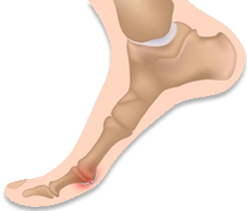Turf Toe (Big Toe Sprain)

Turf toe is commonly described as a sprain of your big toe joint. Turf toe occurs by jamming the big toe or repeatedly pushing off of the big toe forcefully. A big toe sprain is most common with football players. However, it affects athletes who participate in sports, such as
- Soccer
- Basketball
- Wrestling
- Gymnastics
- Dance
What are Symptoms of Turf Toe
There are many symptoms of surf toe, although the most common as follows:
- Swelling
- Toe pain
- limited joint movement
These symptoms develop slowly though and they gradually worsen over time. Especially, when caused by repetitive injury. However, if turf toe is caused by a forceful motion, it becomes painful instantly. And worsen within 24 hours. Sometimes, a pop is felt. Although it’s more common for the entire joint to be involved and, therefore, limited toe movement.
Causes of a Big Toe Sprain
Turf toe is a sprain to the ligaments in the big toe. These ligaments work as a hinge to allow for up and down movement. And just behind this joint in the ball of your foot is where two pea-shaped bones live. In fact, they are embedded in the tendon that moves your big toe, called sesamoids. Now, for leverage when you walk, these are the bones that act as a pulley for movement, such as walking or running. Also, they absorb the weight that presses on the ball of the foot.
So, why is it important for us to absorb the weight of the ball of our foot?
Well, when walking or running, we start each step by raising our heels and letting the body weight come forward onto the ball of our foot. Now, at a certain point, we bring ourselves forward by pushing off of the big toe and therefore, allowing weight to shift to the other foot. Therefore, running the risk of injuring yourself if the toe remains flat on the ground and doesn’t push off.
Treating Turf Toe
When turf toe (a big toe sprain) occurs, initially, the RICE method should be used. The rice method includes rest, ice, and elevation. Therefore, allowing for a basic treatment immediately after the injury. Furthermore, over-the-counter medications can also help to alleviate inflammation and control the pain.
A physician will most likely wrap the injury and prescribe crutches. Crutches are also normal to relieve stress on the injury. Sometimes, a cast or boot will also be prescribed. However, in severe cases, a surgeon will suggest surgical treatment.
These injuries can vary in severity from stretching the soft tissue to partial tearing. Sometimes, even dislocation may occur. However, for treatment, there are three grades that doctors use, such as:
Grade 1. The plantar complex has been stretched causing pin-point tenderness and slight swelling.
Grade 2. A partial tearing of the plantar complex causes more widespread tenderness, moderate swelling, and bruising. Movement of the toe is limited and painful.
Grade 3. The plantar complex is completely torn causing severe tenderness, severe swelling, and bruising. It is difficult and painful to move the big toe.
Pain relief will take between two to three weeks to subside. Thereafter, physical therapy will likely be prescribed. A physical therapist will help you to re-establish the strength and range of motion of the injured toe.
Also, see: Can Textured Insoles Prevent Sports Injuries?
If you suspect a big toe sprain (turf toe), call us at 888-409-8006. Our award-winning foot surgeon is here to help.
